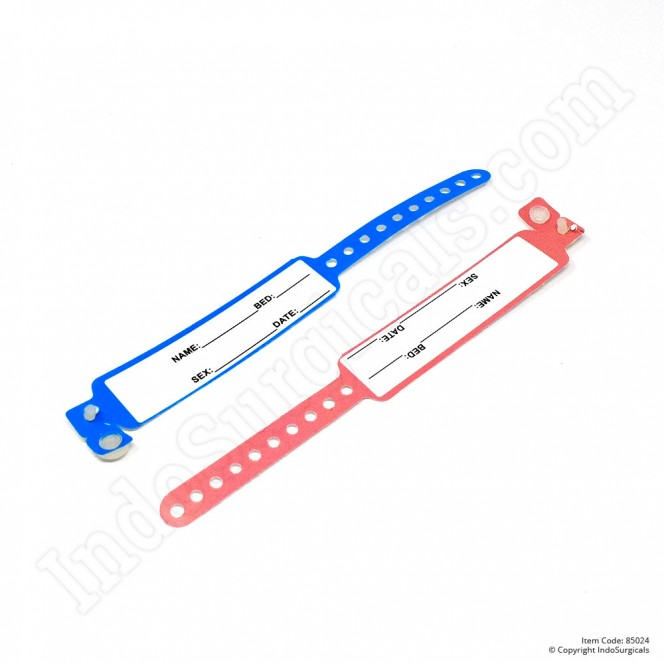The Relationship Between a Patient Identification Band and Enhanced Patient Privacy
The Relationship Between a Patient Identification Band and Enhanced Patient Privacy
Blog Article
A Comprehensive Guide to Patient Identification Band as a Vital Medical Supply
In the substantial landscape of medical care, Patient Identification bands have actually become an important tool (patient identification band). These bands, brimming with essential data, work as the initial line of protection versus clinical errors and ensure smooth Patient treatment. As we start to explore these clinical materials extensive, we reveal the complexities of their layout, usage, and effect on Patient safety, while hinting at the assurance they hold for future clinical practices
The Duty of Patient Identification Bands in Healthcare
The value of Patient Identification bands in health care can not be overemphasized. These straightforward wristbands act as the key method of making certain Patient identification, lowering the danger of clinical mistakes and improving overall Patient safety. They are a vital tool in verifying a patient's identity before carrying out treatments, drugs, or carrying out treatments. They are typically color-coded to denote various health and wellness problems, allergic reactions, or danger factors, enabling quick visual Identification by health care experts. In the hectic, high-pressure world of medical care, where human lives are at risk, the benefits of such an easy yet effective tool are important. Patient Identification bands supply a system of checks and equilibriums, a fail-safe against potential errors, and a continuous suggestion of the private behind the treatment.
Deciphering the Info on Patient Identification Bands
While they might appear easy at a glimpse, Patient Identification bands bring crucial details that can greatly affect the course of a patient's care. These bands commonly present the Patient's name, date of birth, and a special identifier, such as a clinical record number. These important pieces of information make sure right Patient Identification, protecting against clinical mistakes. Some bands might also include essential clinical notifies, such as allergic reaction information, which can be vital in stopping unfavorable responses. Additionally, the barcode discovered on these bands can be checked to access the Patient's electronic health document, providing a wide range of information to doctor. Comprehending the information on these bands is necessary for safe and efficient Patient treatment.
Different Kinds Of Patient Identification Bands: A Closer Appearance
In the realm of Patient Identification, there are several sorts of bands that offer unique purposes. Barcode Identification Bands, RFID Tag-based Bands, and Color-Coded Patient Bands are the main categories - patient identification band. Each type provides unique functions and advantages, which will certainly be taken a look at in the complying with sections
Barcode Identification Bands
Offering a considerable renovation in Patient safety and security, barcode Identification bands have become an important tool in the medical area. These bands shop vital Patient information in a barcode layout that's quickly accessible with a scan. This lowers the opportunity of human error in Patient Identification and information access, which is critical in clinical procedures. The barcode system makes information like Patient name, case history, allergies, and recommended medications readily offered. This ensures quick and correct Patient Identification, specifically in emergency situation situations where every 2nd counts. Barcode Identification bands are likewise very easy to make use of, affordable and long lasting, making them an essential component of modern healthcare. Importantly, these bands have actually considerably minimized medical mistakes and enhanced Patient safety.
RFID Tag-based Bands
An additional ingenious strategy in Patient Identification is the use of RFID Tag-based bands. These bands make use of Superhigh frequency Identification (RFID) innovation to provide a safe and secure kind of Patient Identification. Unlike barcodes, RFID tags can save far more information and can be checked out without straight line of vision. This implies that healthcare professionals can access vital Patient information, also if the band is covered by garments or bed linen. RFID tags can be reprogrammed with updated info as required, improving their functionality. These bands can be extra costly than other forms of Identification, and there are personal privacy problems associated with the use of RFID modern technology. In spite of these difficulties, RFID tags use considerable possibility for improving Patient safety and effectiveness in healthcare.
Color-Coded Patient Bands
Color-coded Patient bands stand as a basic yet reliable tool in Patient Identification. These bands, prevalent in medical facilities and clinics, utilize various colors to suggest different Patient conditions, risks or allergic reactions, guaranteeing immediate recognition by healthcare professionals. A red band typically indicates an allergic reaction, while yellow shows a fall danger. These bands are made to be distinguishable and quickly visible, also in high-stress scenarios. This instant aesthetic hint enables for timely, exact treatment, lowering the capacity for clinical mistakes. It's important that team are thoroughly trained in the color definitions, as complication can lead to significant consequences. Therefore, the color-coded my review here Patient band system is a crucial part of Patient safety and reliable health care distribution.
,aspect=fit)
Use of Patient Identification Bands: Procedures and Methods
In medical care settings, the use of Patient Identification bands plays a pivotal function in guaranteeing Patient safety and reducing medical mistakes (patient identification band). These bands, typically made of durable, hypoallergenic material, are affixed to the Patient's wrist or ankle, presenting important information such as name, day of birth, and a special identifier. In elderly care, two bands might be used for individuals with mental deterioration to make sure correct Identification.
The Impact of Identification Bands on Patient Safety
Identification bands play a vital function in preserving Patient safety in healthcare settings. Their usage can dramatically lower medical errors by ensuring that the best Patient receives the correct treatment. In addition, these basic devices add to improving the quality of care by providing an extra layer of confirmation to Patient identifications.
Minimizing Clinical Mistakes
Patient Identification bands have actually emerged as an indispensable device in dramatically lowering these mistakes. Most importantly, these bands make certain that every Patient is properly matched with their medical records, examinations, and treatments, therefore significantly decreasing the risk of medical errors. By making certain exact Patient Identification, these bands contribute to improved Patient security, developing trust and confidence in the healthcare system.
Guaranteeing Proper Treatment
Guarding Patient security, Identification bands play a critical role in ensuring the appropriate administration of therapies. These bands contain important info such as the Patient's name, date of birth, and unique Identification number. In essence, Patient Identification bands serve as an important guard in the healthcare setup, dramatically contributing to Patient safety and security and ensuring correct therapy.

Enhancing High Quality Treatment
While they might show up website here irrelevant, patient Identification bands substantially enhance the top quality of treatment given in medical care settings. They are an important tool in making sure Patient safety and security because of their ability to provide instant accessibility to vital information. This consists of the Patient's case history, allergic reactions, and existing treatment plans. Utilizing these bands reduces the threat of medical mistakes, such as incorrect drug management or operations. Furthermore, they strengthen the personal link between medical care provider and go to this website Patient, raising count on and communication. This easy, affordable band thus plays an essential role in Patient safety, substantially influencing the total quality of care. The adoption of Patient Identification bands is, therefore, a required measure in all healthcare settings.
Checking out the Future of Patient Identification Bands in Medical Technique

Final thought
Patient Identification bands play a crucial function in healthcare, making certain accurate Patient Identification and lowering medical errors. As medical techniques continue to advance, Patient Identification bands will certainly stay a vital component of the health care system.
While they might seem basic at a look, Patient Identification bands carry essential details that can significantly affect the training course of an individual's treatment.Color-coded Patient bands stand as a basic yet efficient tool in Patient Identification.In health care settings, the usage of Patient Identification bands plays an essential function in making certain Patient security and minimizing clinical mistakes. In essence, Patient Identification bands offer as an essential protect in the health care setup, substantially contributing to Patient safety and guaranteeing proper therapy.
Patient Identification bands play an important duty in medical care, ensuring accurate Patient Identification and decreasing clinical mistakes.
Report this page